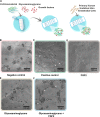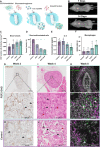Controlled release of growth factors using synthetic glycosaminoglycans in a modular macroporous scaffold for tissue regeneration
- PMID: 36482075
- PMCID: PMC9732287
- DOI: 10.1038/s42003-022-04305-9
Controlled release of growth factors using synthetic glycosaminoglycans in a modular macroporous scaffold for tissue regeneration
Abstract
Healthy regeneration of tissue relies on a well-orchestrated release of growth factors. Herein, we show the use of synthetic glycosaminoglycans for controlled binding and release of growth factors to induce a desired cellular response. First, we screened glycosaminoglycans with growth factors of interest to determine kon (association rate constant), koff (dissociation rate constant), and Kd (equilibrium rate constant). As proof-of-concept, we functionalized an elastin-like recombinamer (ELR) hydrogel with a synthetic glycosaminoglycan and immobilized fibroblast growth factor 2 (FGF2), demonstrating that human umbilical vein endothelial cells cultured on top of ELR hydrogel differentiated into tube-like structures. Taking this concept further, we developed a tunable macroporous ELR cryogel material, containing a synthetic glycosaminoglycan and FGF2 that showed increased blood vessel formation and reduced immune response compared to control when implanted in a subcutaneous mouse model. These results demonstrated the possibility for specific release of desired growth factors in/from a modular 3D scaffold in vitro and in vivo.
© 2022. The Author(s).
Conflict of interest statement
The authors declare the following competing interests: J.L. is founder of Glycan Therapeutics LLC. The remaining authors declare no competing interests.
Figures




Similar articles
-
Combining tunable proteolytic sequences and a VEGF-mimetic peptide for the spatiotemporal control of angiogenesis within Elastin-Like Recombinamer scaffolds.Acta Biomater. 2021 Aug;130:149-160. doi: 10.1016/j.actbio.2021.06.005. Epub 2021 Jun 9. Acta Biomater. 2021. PMID: 34118450
-
Dual release of growth factor from nanocomposite fibrous scaffold promotes vascularisation and bone regeneration in rat critical sized calvarial defect.Acta Biomater. 2018 Sep 15;78:36-47. doi: 10.1016/j.actbio.2018.07.050. Epub 2018 Jul 29. Acta Biomater. 2018. PMID: 30067947
-
Functional characterization of an enzymatically degradable multi-bioactive elastin-like recombinamer.Int J Biol Macromol. 2020 Dec 1;164:1640-1648. doi: 10.1016/j.ijbiomac.2020.08.004. Epub 2020 Aug 3. Int J Biol Macromol. 2020. PMID: 32758602
-
Glycosaminoglycan-Based Cryogels as Scaffolds for Cell Cultivation and Tissue Regeneration.Molecules. 2021 Sep 15;26(18):5597. doi: 10.3390/molecules26185597. Molecules. 2021. PMID: 34577067 Free PMC article. Review.
-
Glycosaminoglycans co-administration enhance insulin-like growth factor-I neuroprotective and neuroregenerative activity in traumatic and genetic models of motor neuron disease: a review.Int J Dev Neurosci. 2000 Jul-Aug;18(4-5):339-46. doi: 10.1016/s0736-5748(00)00015-0. Int J Dev Neurosci. 2000. PMID: 10817918 Review.
Cited by
-
Investigating Immunomodulatory Biomaterials for Preventing the Foreign Body Response.Bioengineering (Basel). 2023 Dec 11;10(12):1411. doi: 10.3390/bioengineering10121411. Bioengineering (Basel). 2023. PMID: 38136002 Free PMC article. Review.
-
Alveolar Organoids in Lung Disease Modeling.Biomolecules. 2024 Jan 16;14(1):115. doi: 10.3390/biom14010115. Biomolecules. 2024. PMID: 38254715 Free PMC article. Review.
-
Chitosan-Based Dressing as a Sustained Delivery System for Bioactive Cytokines.Int J Mol Sci. 2023 Dec 19;25(1):30. doi: 10.3390/ijms25010030. Int J Mol Sci. 2023. PMID: 38203201 Free PMC article.
References
Publication types
MeSH terms
Substances
Grants and funding
LinkOut - more resources
Full Text Sources
Research Materials

